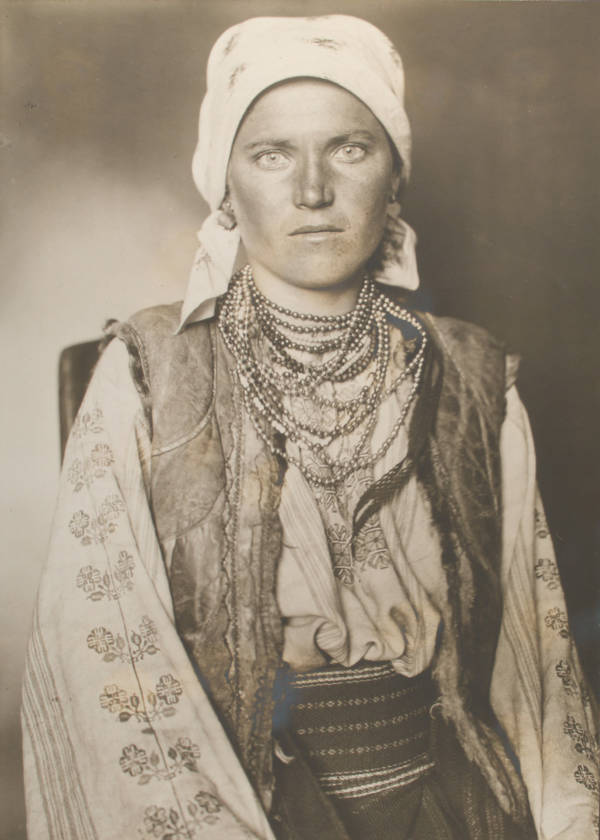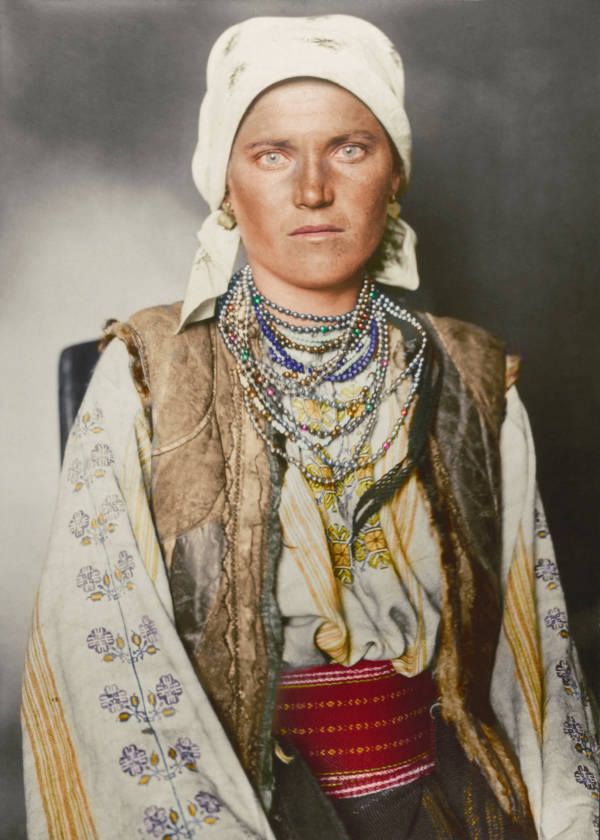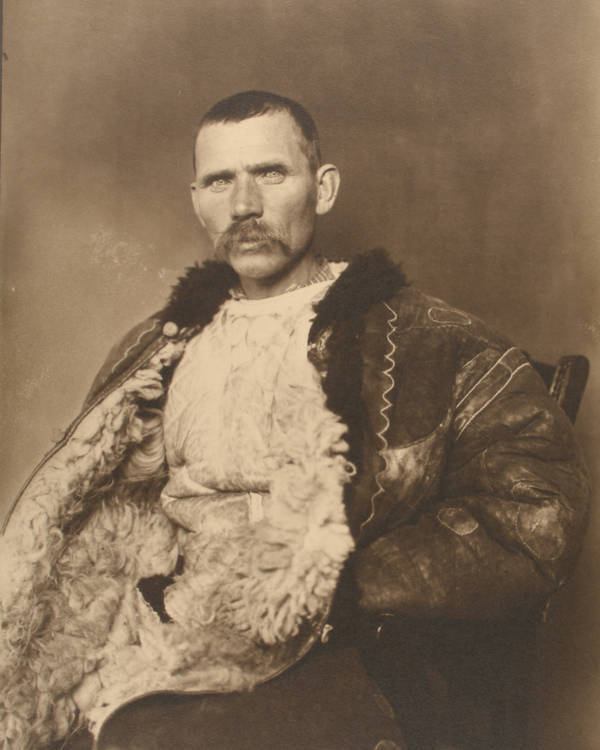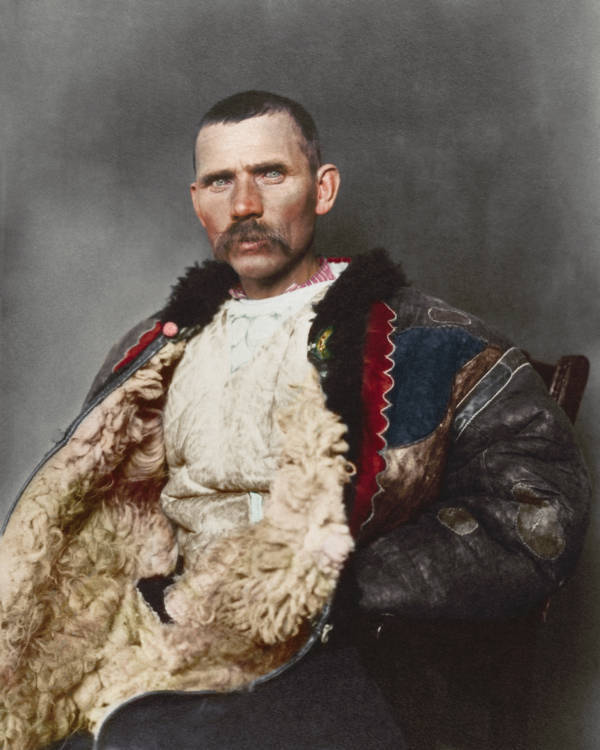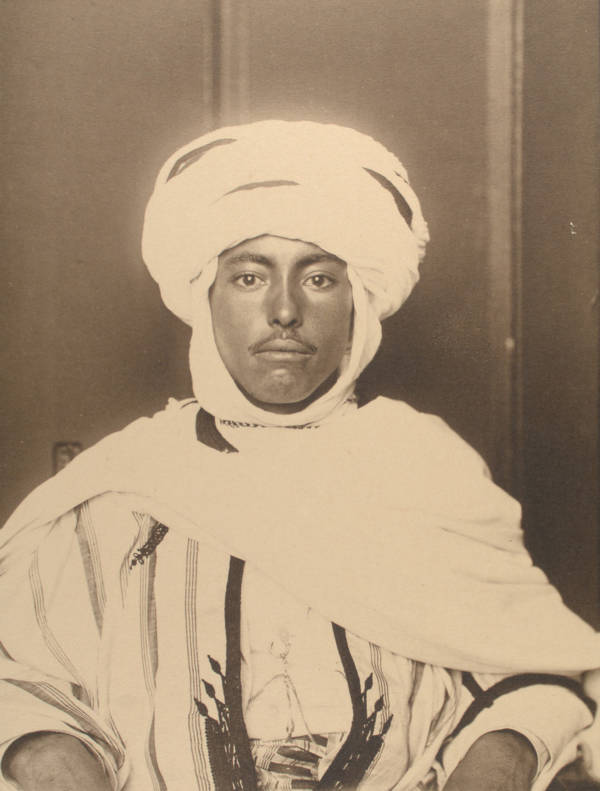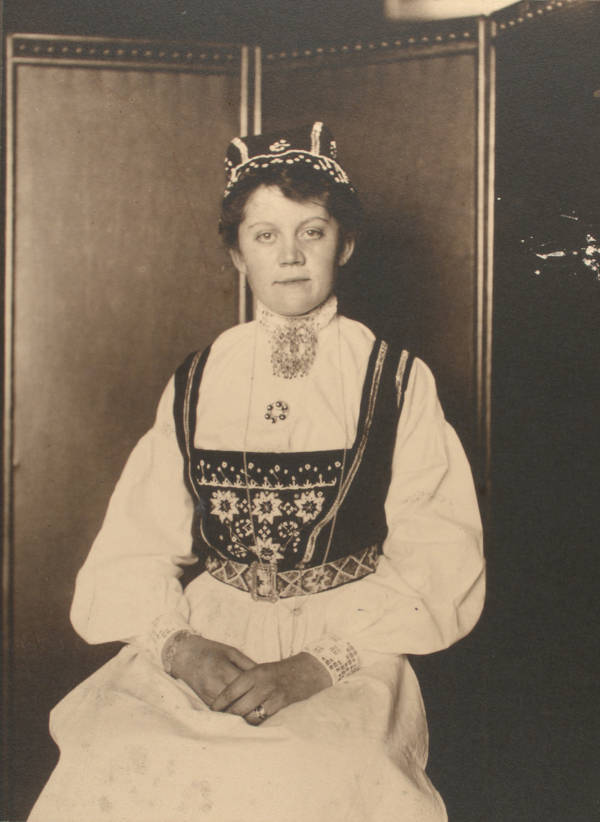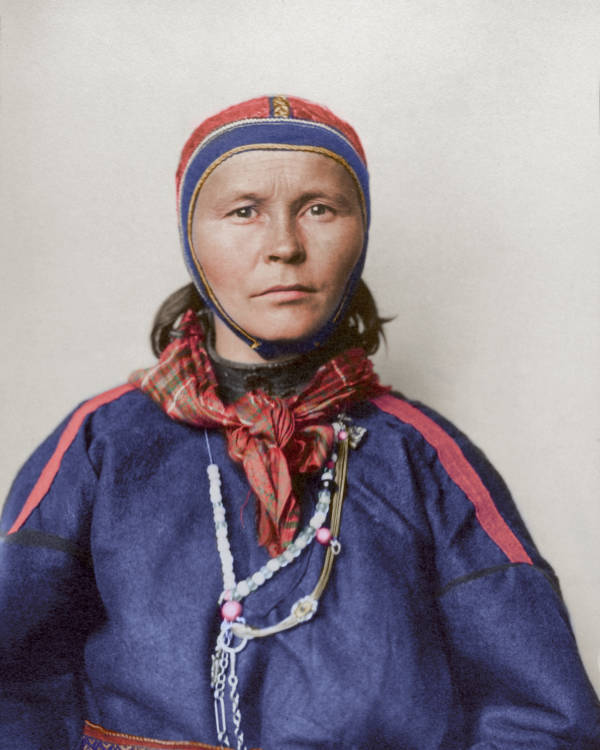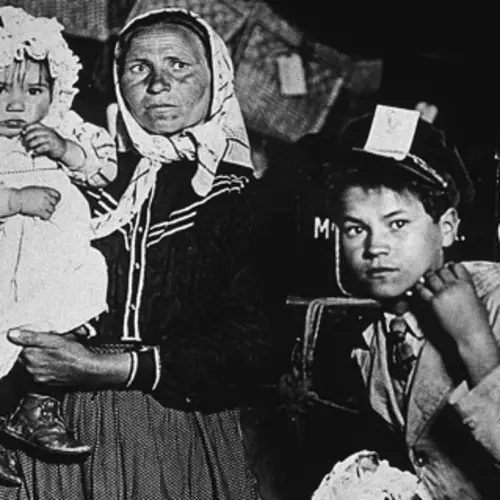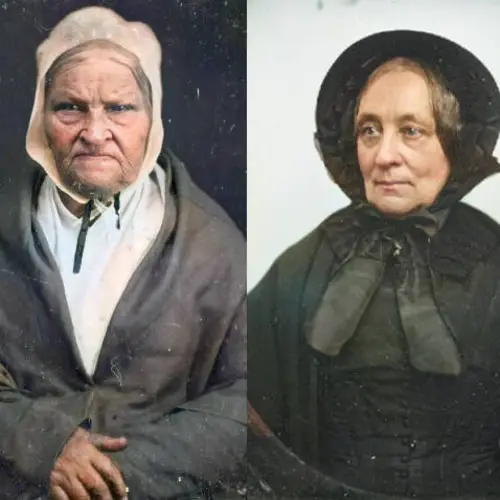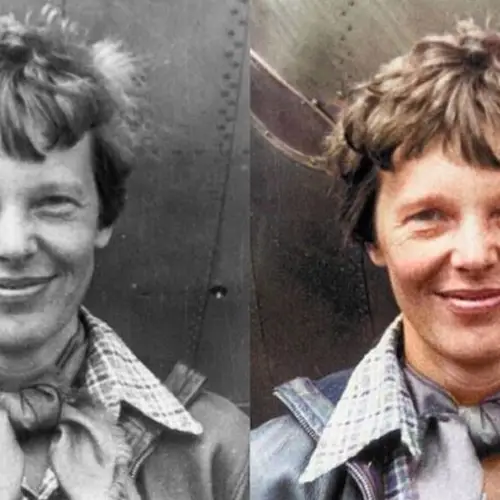1 of 33
"Ruthenian woman." Circa 1906.
While there are clues in her garments, the exact home village of this "Ruthenian woman," as she was originally titled, is uncertain. Her costume is characteristic of the Bukovina region that is today divided between Ukraine and Romania. The embroidered motifs on her linen blouse suggest that she is likely from the Ukrainian side, but useful details are concealed by the lack of color in the original image.Augustus Francis Sherman/New York Public Library
2 of 33
Augustus Francis Sherman/New York Public Library/Dynamichrome
3 of 33
"Romanian shepherd." Circa 1906.
Dominating the photograph is a traditional shepherd's coat known as a sarica, made of three to four sheepskins sewn together. Depending on the region and style, a sarica could be worn either with the fleece facing inwards, as seen here, or outwards, resulting in an entirely different aesthetic. The size and softness of the garment also made it suitable for use as a pillow when sleeping outdoors.Augustus Francis Sherman/New York Public Library
4 of 33
Augustus Francis Sherman/New York Public Library/Dynamichrome
5 of 33
"Algerian man." Circa 1910.
The large turban style headdress is made up of a large square of fabric folded and wrapped around a fez hat and secured using a special cord. Visible beneath the djellaba robe is a multi-colored, striped silk belt that was common throughout the Ottoman Empire. These belts had different regional names (e.g. taraboulous) revealing the city where they were made — in this case, Tripoli (Ṭarābulus in Arabic).Augustus Francis Sherman/New York Public Library
6 of 33
Augustus Francis Sherman/New York Public Library/Dynamichrome
7 of 33
“Cossack man.” Date unspecified.
This man is wearing a traditional costume that enjoyed widespread popularity throughout the Caucasus, most notably among the population living in modern-day Georgia. The choka overcoat along with the traditional swords and daggers were seen both as elements of folk dress and military uniform and continue to be worn in the region today. The rows of tubes across his chest are metal-capped wooden gun powder containers. Once functional, they remain as purely decorative elements today.Augustus Francis Sherman/New York Public Library
8 of 33
Augustus Francis Sherman/New York Public Library/Dynamichrome
9 of 33
"Guadeloupean Woman." Circa 1911.
The elaborate tartan headpiece symbolizing marital status or mood worn by Guadeloupean women can be traced back to the Middle Ages. First plain, then striped and in increasingly elaborate patterns, the Madras fabric exported from India and used as head wraps was eventually influenced by the Scottish in colonial India, leading to a Madras-inspired tartan known as "Madrasi checks."Augustus Francis Sherman/New York Public Library
10 of 33
Augustus Francis Sherman/New York Public Library/Dynamichrome
11 of 33
"Danish man." Circa 1909.
Evolving since the 1750s, the Danish dress was simple, with more decorated attire saved for special occasions. As with many nations before mass industrialization, much of the clothing was homespun. In contrast, this man is wearing clothing made of commercial cloth and a hat that suggests he is wearing a uniform reflecting his profession rather than a strictly regional costume. His tailored jacket is decorated with metal buttons and a chain.Augustus Francis Sherman/New York Public Library
12 of 33
Augustus Francis Sherman/New York Public Library/Dynamichrome
13 of 33
“Norwegian woman.” Circa 1906-1914.
This woman is wearing a bunad from the Hardanger region, one of the most famous in all of Norway. The main elements of this bunad are decorated with elaborate beadwork. Bunad is the Norwegian term for regional clothing that developed through traditional folk costumes. In some regions, the bunad is a direct continuation of the local peasant style, while in others, it was reconstructed based on historical information and personal tastes.Augustus Francis Sherman/New York Public Library
14 of 33
Augustus Francis Sherman/New York Public Library/Dynamichrome
15 of 33
"Hindoo boy." 1911.
The topi (cap) is worn all over the Indian subcontinent with many regional variations. It is especially common in Muslim communities, where it is known as a taqiyah. Both the cotton khadi and the prayer shawl are likely to have been hand-spun on a charkha, and were used all year round.Augustus Francis Sherman/New York Public Library
16 of 33
Augustus Francis Sherman/New York Public Library/Dynamichrome
17 of 33
"Bavarian man." Circa 1910.
Traditional dress in Germany is known as Tracht(en) and, as with other nations, there are many regional variations. In the Alpine region, leather breeches known as lederhosen were worn regularly by men and became part of the typical Bavarian style known as Miesbacher Tracht. This standardized form is exemplified here and is now typically associated with the annual Oktoberfest. The gray jacket is made from fulled wool and decorated with horn buttons.Augustus Francis Sherman/New York Public Library
18 of 33
Augustus Francis Sherman/New York Public Library/Dynamichrome
19 of 33
"Italian woman." Circa 1910.
Elements of this dress may have been homemade, though accessories such as the kerchief and earrings would have had to have been purchased, as these items would have meant a considerable expense for many peasants. The color and cut of individual garments were often region specific, though manufactured elements such as shawls were a common feature throughout Italy. For special occasions such as weddings, women often wore highly decorative aprons made of expensive floral brocade fabrics.Augustus Francis Sherman/New York Public Library
20 of 33
Augustus Francis Sherman/New York Public Library/Dynamichrome
21 of 33
"Romanian piper." Circa 1910.
This man's sheepskin garments are noticeably plainer than the shepherd seen elsewhere in this gallery, indicating his relative lack of financial wealth. He is likely a farm laborer, but the fact that he has posed with an instrument could suggest that his earnings were supplemented at least in part by playing music. The waistcoat, known as a pieptar, was worn by both men and women and came in a variety of shapes, sizes, and ornamental styles depending on the region.Augustus Francis Sherman/New York Public Library
22 of 33
Augustus Francis Sherman/New York Public Library/Dynamichrome
23 of 33
"Rev. Joseph Vasilon, Greek-Orthodox priest." Circa 1910.
The vestments of the Greek Orthodox church have remained largely unchanged. In this
photograph, the priest wears an anteri, an ankle-length cassock (from the Turkish quzzak, from which the term "Cossack" also derives) worn by all clergymen over which an amaniko, a type of cassock vest, is sometimes worn. The stiff cylindrical hat is called a kalimavkion and worn during services.Augustus Francis Sherman/New York Public Library
24 of 33
Augustus Francis Sherman/New York Public Library/Dynamichrome
25 of 33
"Laplander." Circa 1910.
Gákti is the traditional costume of the Sámi people of the Arctic regions spanning from northern Norway to the Kola Peninsula in Russia. Traditionally made from reindeer leather and wool, velvet and silks are also used, with the (typically) blue pullover supplemented by contrasting colored banding of plaits, brooches, and jewelry. The decorations are region-specific.Augustus Francis Sherman/New York Public Library
26 of 33
Augustus Francis Sherman/New York Public Library/Dynamichrome
27 of 33
"Alsace-Lorraine girl." 1906.
Originating in the Germanic-speaking region of Alsace, now in modern-day France, the
large bow in this regional dress is known as a schlupfkàpp and was worn by single women. The bows signified the bearer’s religion — Protestants generally wore black, while Catholics favored brightly colored bows.Augustus Francis Sherman/New York Public Library
28 of 33
Augustus Francis Sherman/New York Public Library/Dynamichrome
29 of 33
"Dutch woman." Circa 1910.
The Dutch bonnet was usually made of white cotton or lace. The shape of the headdress in addition to the gold pins and square stikken identify where this woman is from (South Beveland), her religion (Protestant), and her marital status (married). Necklaces in this region were often red coral, though black was also common especially during times of mourning. Other elements of the dress changed over time depending on the availability of fabrics.Augustus Francis Sherman/New York Public Library
30 of 33
Augustus Francis Sherman/New York Public Library/Dynamichrome
31 of 33
"Albanian soldier." Circa 1910.
The truncated, brimless felt cap is known as a qeleshe. Its shape was largely determined by region and moulded to one’s head. The vest, a jelek or xhamadan, was decorated with embroidered braids of silk or cotton. Color and decoration denoted the regional home of the wearer and their social rank. This man is likely to come from the northern regions of Albania.Augustus Francis Sherman/New York Public Library
32 of 33
Augustus Francis Sherman/New York Public Library/Dynamichrome
33 of 33
Like this gallery?
Share it:
